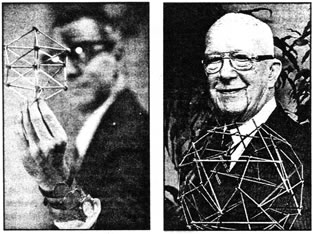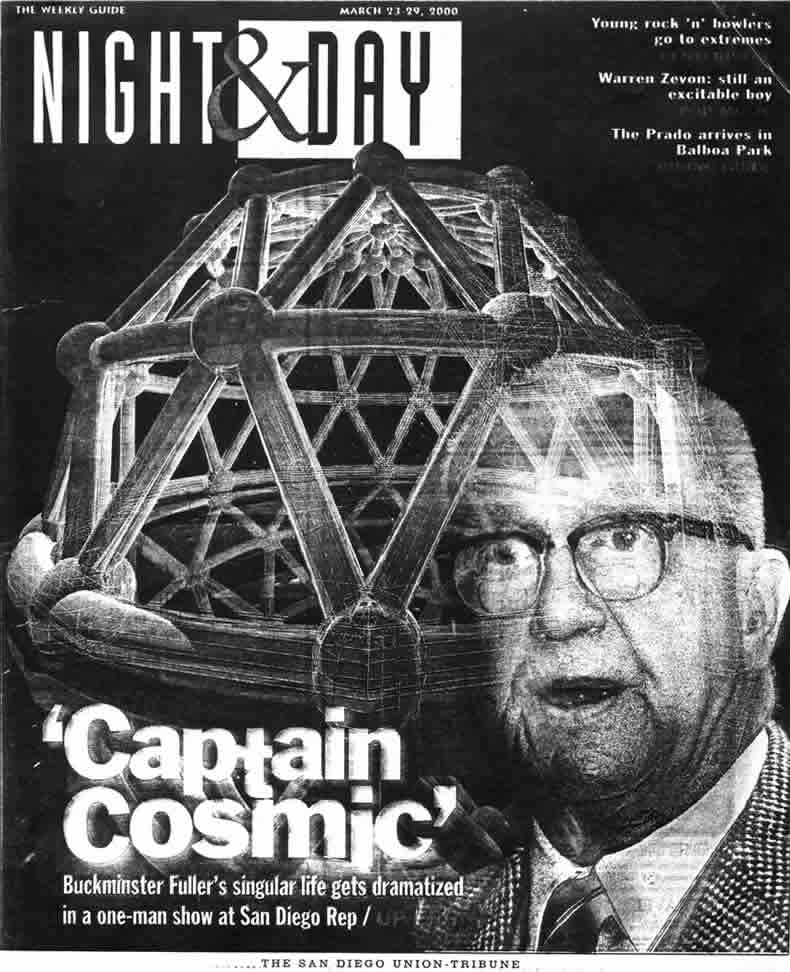 Spaceship fuller'THE HISTORY (AND MYSTERY) OF THE UNIVERSE' IS A TRIBUTE TO A 20TH-CENTURY RENAISSANCE MAN
By Anne Marie Welsh, theater critic, March 23, 2000 San Diego Union Tribune Spring 1968: one wild season. The Chicago Democratic convention. The assassination of Robert Kennedy and Rev. Martin Luther King, Jr. Race riots in Detroit. That year, too, San Diego Rep. cofounder Doug Jacobs took his first theater class (at UC Santa Barbara) and heard R. Buckminster Fuller speak. "I watched him speak for a while, then I went to a biology class, then back to watch him speak some more," Jacobs says. "Then I went to dinner, then came back and he was still talking. Then to a rehearsal and back, and the place was even more packed, with people hanging out of windows. Here was a little man in a dark suit. He'd talk for 20 minutes with his eyes closed, and you'd wonder what he was talking about and then suddenly you would realize you had hopped on the train and were with him." Jacobs didn't know it then, but he has never really gotten off the train. Next week, the Rep premieres Jacobs' "R. Buckminster Fuller: The History (and Mystery) of the Universe," a one-man show performed by Ron Campbell and based on the life work and writings of the Renaissance man people still call "Bucky." Fuller's comprehensive approach to knowledge "influenced me as much as anything, as opposed to his specific ideas. Some of his ideas were so strange I couldn't wrap my head around them," Jacobs said. Still, Fuller's ideas resonated with Jacobs all those years he performed with Magique, a street theater group, then acted, wrote and directed for the Rep. Jacobs considered writing a one-man show about Fuller to perform himself. Then in 1995, GENI (the San Diego-based Global Energy Network International, directed by Peter Meisen) approached Jacobs to help find a theater and stage an event for the centennial of Fuller's birth. Around the same time, the multitalented Campbell, a great physical comic, came into the picture. "Ron was doing a lot of work at Rep, and I began to see a lot o f rhythmic parallels. Ron is very physical ... rhythmically clear, aggressively curious. So around that time, I began thinking of building the piece around Ron's skills." Fuller coined the term "Spaceship Earth" (among others), and promulgated the idea that individuals are responsible for the planet, and thus should "Think globally, act locally." Although he is best-known as the creator of the geodesic dome - the honeycomb sphere of triangular parts - Fuller also imagined a new math system, an end to world hunger, and streamlined, energy-efficient auto, the Dymaxion. "You would have to compare Leonardo da Vinci,"says Jacob's of the artist, inventor, poet, architect, philosopher and author. Fuller's preferred title: Comprehensive anticipatory Design Scientist. "The most interesting thing about him in the 60's was that he cut across problems differently from anyone else. He was really forcing people to rethink how they perceived and organized knowledge. He brought people into one room who would not be spending time together ordinarily: the military with anti-military people, hippies, artists, and scientists." Fuller's daughter, Allegra Snyder, a dance ethnologist and retired chair of the dance department at UCLA, said her father's small (5-foot-5) jolly physical appearance was deceiving: " When he talked, he became so impassioned that a kind of energy radiated from him. I drew people to him." And boy, could Bucky talk. His most famous appearance came in front of a video camera in 1975. HE began reciting all he knew about his life, work and human history. Forty-three hours later, he stopped, having never repeated himself. To create "History (and Mystery)," Jacobs said he imagined he was structures "a really interesting poetry reading, one that had more of a through-line. How do I get really contrasting kinds of language rhetoric, and music? It is a bit of a collage, yet to some degree there is almost a three-act structure hidden. I kept trying to expand it out from his roots in his family into what Freud called the problems of love and work." Fuller was born to the old and distinguished New England family that produced Margaret Fuller, who helped publish the works of Emerson. Buckminster Fuller, however, got off to a shaky start. Expelled twice from Harvard, he worked in a Canadian machinery factory. He married Anne Hewlett, a union that lasted 66 years until they died, two days apart in 1983. Jacobs' script, based mostly on Fuller's voluminous writing, deals at length with the life-changing event: the death of their 4-year-old daughter, Alexandra, in 1922, a grief that plunged him into an alcoholic stupor, cost him his job, and nearly his life. It was then that Fuller realized his life belonged to the universe, not to himself. "Like Gandhi," Jacob says, " Bucky decided to turn his life into an experiment to see if he could live by his principles." Chief among those was the notion that individuals can actually affect global change. Campbell will illustrate some of Bucky's ideas by manipulating objects - the geometric shapes that Fuller saw as central of the universe, shapes that transform into one another in a reflection of what he saw as the "pumping action" of the cosmos. Famed British designer Annie Smart is designing the show, which will have new music by Luis Perez. We're not doing an impersonation of Bucky. The family was relieved to hear we weren't doing that. Ron has a phenomenal amount of energy and drive, which is very parallel to what Fuller had. People may think they're seeing the force of his mind and energy on stage. But it's not about impersonation; it's about trying to make the intentions of his life come alive." Fuller had the capacity to help people see how much more possibility there was to life. "What was invigorating about that was not that you were made to feel ignorant, but you were made to feel that innate curiosity of a child." The title of his show came from Snyder, who was corrected Jacobs when he asked if Fuller was writing the history of the universe: "The history and the mystery of the universe," the daughter of the genius said. And is the writer-director satisfied with the show. "Yeah, I am," Jacobs said, " although the whole attempt is somewhat presumptuous in a way, but I think that's how Bucky wanted people to be."
|
Email this page to a friend
If you speak another language fluently and you liked this page, make
a contribution by translating
it! For additional translations check out FreeTranslation.com
(Voor vertaling van Engels tot Nederlands)
(For oversettelse fra Engelsk til Norsk)
(Для дополнительных
переводов проверяют
FreeTranslation.com )



